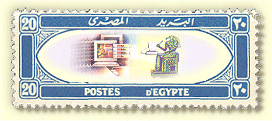

| Report of the Meeting, July 7, 2018. Laurence Kimpton, Baghdad-Cairo Air Mails | |
|
Despite the alternative attractions of stunning summer weather and a football match in Russia, a very select group of members met at the
Victory Services Club – small, but perfectly formed.
Nine members and one guest attended; there were apologies for absence from 12 members. The Chairman welcomed those attending, and particularly John and Pat Sears, and was pleased to announce that that Peter Andrews’ family had generously agreed that we might auction his collections: look forward to a fascinating ESC auction in September/October. At about the same time, however, Grosvenors will handle the dispersal of the material of Alan Jeyes, our respected former Secretary/Treasurer. Admin was quickly dealt with, the Secretary announcing that David Feldmans had recently published two more books of Joe Chalhoub in the “Great Philatelic Collections” series – Foreign Post Offices and Post Offices Abroad. The Commemoratives volume is already out of print. He noted a couple of changes to the future meetings programme – including a “Pyramids” topic for September 15 (please bring along any suitable material). And he presented some illustrations pertaining to Auguste Gorff, German keeper of the Bavarian Beerhall in Cairo during the later 1800s, and asks members – on behalf of a German researcher in Egypt - if they have any Gorff memorabilia. The illustrated card (below) is probably the best known, but any extra information would be gratefully received. There was something of a surprise when he showed a recent packet of stamps received from the Philatelic Bureau in Cairo – clearly so marked – that had been opened and resealed by a purple strip from the (UK) Home Office / Border Force. Has anyone seen another? 
There was another surprise when Laurence Kimpton opened up his magnificent display, with three rounds of frames each holding 48 sheets and detailing as
much as anyone could possibly want to know about the early mail services between Cairo and Baghdad. His research not only into the mails and the mail
services but also into the aircraft (and other forms of transport) that carried them, not to mention the men who actually flew the planes, was nothing
short of prodigious, as his recently published book also indicates.
Cover from Baghdad to England flown by RAF DH 4 on first flight carrying mail westward.
As Britain’s major “representative” in the area and the guardian of the sea routes, it would have been unthinkable in No 10 for any other of the great nations to usurp its role – until two New Zealander brothers came along in mid-1923 with a typically Down Under flair for innovation and for cocking a snook at authority with the Nairn Motor Mail service. There was fierce competition between the RAF and motor services between 1923 and 1926, when the RAF abandoned the service, which was taken over by Imperial Airways and extended to Basra. The Nairn intervention shook up the established air services and led to a reduction in fees for mails in both directions. But Laurence managed to stay well on top of the plethora of minimal changes, and en route showed some wonderful covers – and dispelled at least one myth: Egypt’s first Air Mail stamp in 1926, showing a De Havilland 34 over the Nile – was a neat piece of artwork. But the DH34 never went to Egypt and was scrapped before the stamp was issued, to be replaced by the Vickers Victoria. Laurence’s display treated those who attended to an impeccable display of an area of which we were all vaguely aware but with little expert knowledge. His enthusiasm and deep research are to be greatly applauded, as the Chairman said in his closing remarks.
Oct 1923: registered cover posted in London for Baghdad franked £1 7s 4d for a packet weighing 2lb 10oz: 2 1/2d postage for first ounce, 1 1/2d for each of 41 subsequent ounces, 6d x 42 air mail fees, 3d registration, 9d late fee. And, remarkably, three ”Seahorse” adhesivesCover from Baghdad to England flown by RAF DH 4 on first flight carrying mail westward.
|
Please address any QC article or comment or concerns to
Mike Murphy at egyptstudycircle@hotmail.com; and any website concerns to
Neil Hitchens at n.hitchens@btopenworld.com
|
|
|